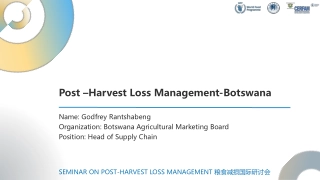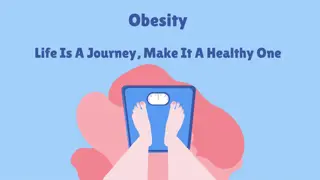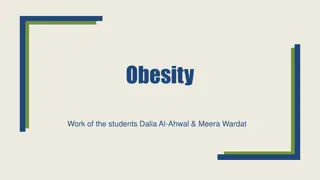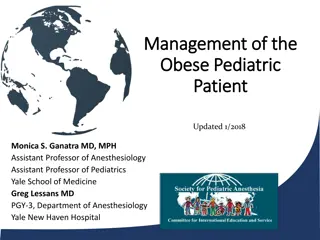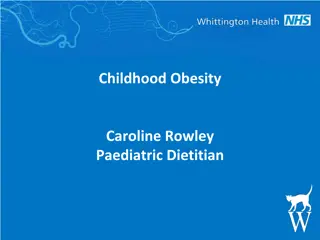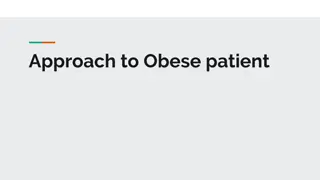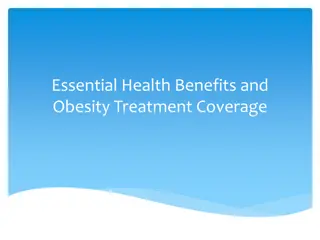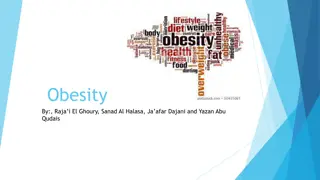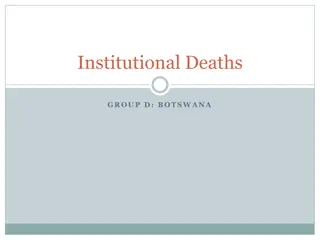Understanding the Multi-Faceted Nature of Obesity in Botswana
Analysis reveals that obesity in Botswana is a complex issue with various contributing factors such as unhealthy diets and physical inactivity. The country faces challenges like poverty affecting dietary choices and inadequate infrastructure for physical activity. Recommendations include a holistic approach involving multiple sectors to address the obesity epidemic.
Download Presentation

Please find below an Image/Link to download the presentation.
The content on the website is provided AS IS for your information and personal use only. It may not be sold, licensed, or shared on other websites without obtaining consent from the author. Download presentation by click this link. If you encounter any issues during the download, it is possible that the publisher has removed the file from their server.
E N D
Presentation Transcript
The analysis of obesity using the layered structure on the social determinants of health shows that obesity denotes obesity as a wicked problem . Obesity cannot be linked to a single cause or solution and addressed by one sector. This means that there are multiple factors that are attributed towards the rising numbers of the occurrence of obesity ranging from individual factors, structural etc Individual choices such as unhealthy diets, physical inactivity are causes of obesity.
Unhealthy diets may be due to either low or high economic status of which poverty is a strong indicator for the former. Physical inactivity may be due to sedentary lifestyles which are eminent in Botswana and unconducive environments/roads or recreational facilities (parks & playgrounds) for physical activity, for examples roads with no walkways or cycling lanes. Unhealthy diets maybe due to issues of food security and trade. Obesity ultimately results in non communicable diseases such as cardiovascular diseases, diabetes, 40% of cancers, chronic respiratory diseases such as Asthma. Data collated by WHO indicates that in Botswana 37% of deaths are due to NCDs and from 2010-2012 there were 16 000 deaths due to NCDs
There are a number of researches conducted in Botswana to gauge obesity levels, for example the a study conducted in 2007 among adults 25- 64 years which revealed low levels of physical activity (73% of inactivity), 22% and 53% of males and females respectively were overweight/obese, low intake of recommended servings of fruits and vegetables (n=96%) , 12% and 5% of school going children were overweight and obese respectively.
This policy brief recommends a robust intersectoral action or multisectoral approach to addressing obesity (HiAP) approach. There are sector Workplace Wellness Programs which are not well coordinated. It is recommended that there be robust workplace wellness policy. MOESD and MOH through health promoting school initiative should formulate dietary guidelines and monitoring framework to monitor its implementation. Physical activity should be promoted by means of engagement with local authorities by facilitating outdoor gym parks, construction of user friendly roads with walkways, lights and cycling paths. Though the MOA is promoting horticulture (backyard gardens) as a way of increasing accessibility of vegetables, water should be subsidized to promote sustainability of this initiative. A lot needs to be done with regard to personal behaviours that cause obesity. Behaviour change communication strategies needs to be implemented across sectors and civil society should be engaged on a larger scale (supported by government, technically and financially
There are evident successes in preventing NCD risk factors : Tobacco, Alcohol consumption If obesity is addressed there will be more economic gain productivity,less of your population spending time accessing care. The health and social care bill will be increased and divert resources to other developments that the city have prioritized Reduce the widening inequalities that may be due to failure to provide appropriate social services Reduced social impacts such as discrimination, social exclusion and reduced earnings : Happy people
The economic cost of obesity Total costs of NCD curative services are estimated at $674,901,517 according to the EHSP 2013 2017.The NCD program is the second most expensive under the EHSP program, accounting for 26 percent of the total costs. The cost of obesity translated into deaths NCDs account to 37% of total deaths in Botswana, which translates to1600 deaths per year. Thousands of days lost to productivity
How much is overweight/obesity in Botswana 1 in 10 and 5 in 10 males and females are overweight/obese. Low levels of vegetable intake:9 in 10 people eat less of the recommended servings of fruits and vegetables 5 in 10 of school going children are obese. 5 in 10 people do not engage in physical activity
Roads and infrastructure The way roads are currently structured has inadequate cycling paths and walkways that can promote physical activity. There are several private gym facilities in towns and cities and major villages. However physical activity can be promoted through cost effective ways such as through establishment of outdoor gym parks in open spaces that can affordably and easily accessed. Currently in Botswana there is only one such park. Workplace Wellness Programs Empirically and through data collected during workplace wellness days, there are high cases of overweight and obesity. The workplace wellness Program came into being with the advent of HIV/AIDS and was since expanded to look at overall employee health. It is inadequately coordinated and narrow in its workplace wellness mandate
School Health environments and Nutrition feeding programmes In many public schools, there are vendors, outside schools doing small business mostly selling snack items high in calories. There are no school based policies to control the type of activities happening around schools. In relation to nutrition feeding programmes there are still some inadequacies as what is being provided in primary public schools dietary wise and safety issues. The diet that is provided is still questionable as to whether it meets the standards of a balanced healthy diet. Knowledge and skills development and community action There is still a lag in investing on communication and social marketing which are the foundations towards behaviour change communication. There are still myths and misconceptions about healthy eating, overweight and obesity and low perceived susceptibility to having NCDs due to a big body. There are still constraints in relation to investing in community action and knowledge and skills development as behaviour change communication is expensive.
Development of a Strategy on reduction of Obesity coordinated at the mayor office Short term strategies may include establishment of outdoor gym parks, development of national dietary guidelines for schools, strengthening behaviour change communication across sectors, water subsidies to promote horticulture at family level. Self help projects/income generating projects for women who do vending around schools Fat and salt reduction project Establishment of an interdepartmental structure/committee at DC level to facilitate intersectoral actions needed for reduction of Obesity.
District Education Office: Haggling Department of Road, Transport and safety: Cooperative Department of Social and Community development: Cooperative Department of Town planning and Development: Cooperative Civil society: Cooperative Fast Food Outlets: Cooperative Business community: Cooperative
Engaging policy-makers Research evidence is most likely to be used by policy- makers when it meets the following needs: Relevance - addresses questions of interest to policy-makers Accessibility - can be easily found and understood by policy-makers Immediacy - evidence is provided in a timely manner for current problems Usefulness - information provides solutions to problems Quality - information is credible and scientifically rigorous Collaborative - early and sustained engagement with policy- makers will increase their understanding of the research and their confidence in using it Targeted - identifies a specific audience and key messages
Frame evidence according to the following questions to facilitate the uptake of research evidence in policy-making: - What is the problem? Why does it matter? What can be done about it? How should we do something? How will we know it worked?
Use an evidence-based approach to engage decision-makers A comprehensive list of facts, tips and resources for effectively presenting evidence to decision-makers and policy-makers . Some facts highlighted include the following: Provide concrete, tangible policy implications of your evidence that provide a solution to a policy issue. Evidence that can be piloted on a small scale can be more readily adopted. Use plain, non-technical language. Tailor evidence to meet the needs of the organizational context. Foster relationships with decision-makers to understand their needs.
Create effective messages Several approaches for creating effective messages, such as social marketing; John Lavis model with four versions of your message (headline, sentence, one-paragraph and full-text version)
Media advocacy Use of civil society by championing a cause Development of policy briefs Development of advocacy tool kits Legislators as icons or champions
Policy brief component Structure: length and clarity Evidence strength Recommended number of pages Data on obesity is available, nonetheless is National weakness Struggling with use of language. Limited evidence on the social causes of obesity, Presentation No Logos, other graphic enhancers
Development of Multisectoral National Strategy on Obesity. Establishment of the National Social Council


